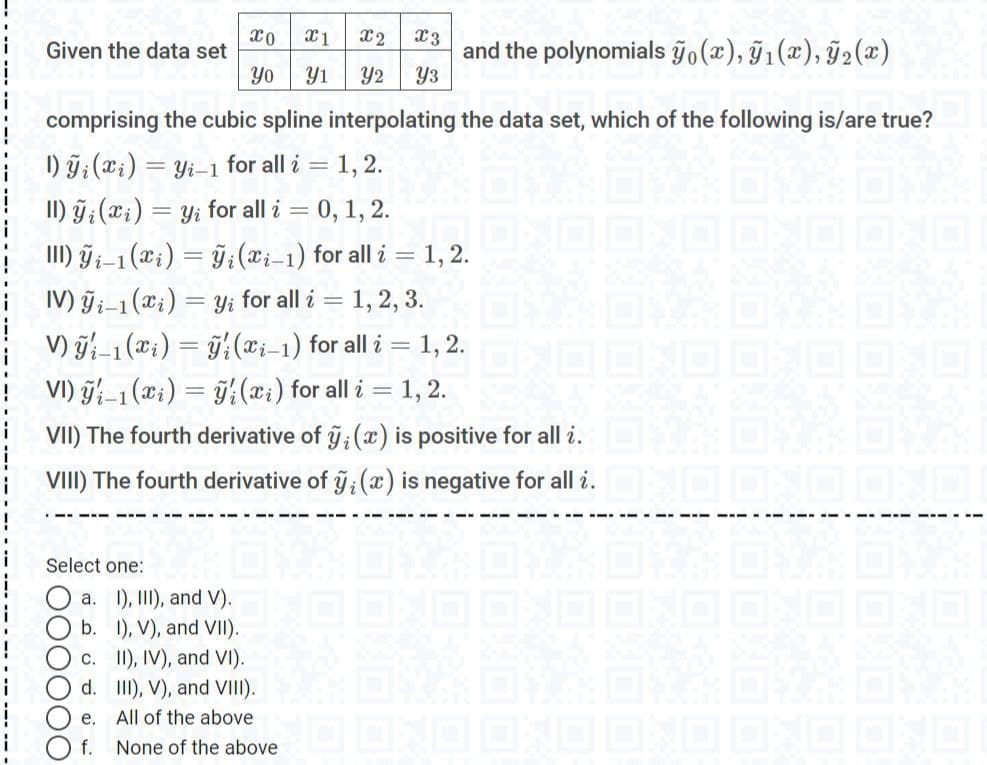xo X1 Given the data set X2 X3 and the polynomials ỹo (x),ỹ₁(x), ₂(x) Yo Yı Y2 Y3 comprising the cubic spline interpolating the data set, which of the following is/are true? 1) yi (xi) = yi-1 for all i = 1, 2. II) y (xi) = y; for all i = 0, 1, 2. III) Yi-1 (xi) = yi (i-1) for all i = 1, 2. Yi for all i = 1, 2, 3. IV) ỹi-1 (xi) = V)ỹi-1 (xi) = y(i-1) for all i = = 1, 2. VI) -1 (xi) = y(xi) for all i = 1, 2. VII) The fourth derivative of Ⓒ; (x) is positive for all i. DNA: OXA DALAM VIII) The fourth derivative of ỹ; (x) is negative for all i. OXO OXO OXO Select one: a. II), II), and V). OXO OXO DNO OX b. 1), V), and VII). c. II), IV), and VI). d. III), V), and VIII). e. All of the above f. None of the above O OXO ONI
xo X1 Given the data set X2 X3 and the polynomials ỹo (x),ỹ₁(x), ₂(x) Yo Yı Y2 Y3 comprising the cubic spline interpolating the data set, which of the following is/are true? 1) yi (xi) = yi-1 for all i = 1, 2. II) y (xi) = y; for all i = 0, 1, 2. III) Yi-1 (xi) = yi (i-1) for all i = 1, 2. Yi for all i = 1, 2, 3. IV) ỹi-1 (xi) = V)ỹi-1 (xi) = y(i-1) for all i = = 1, 2. VI) -1 (xi) = y(xi) for all i = 1, 2. VII) The fourth derivative of Ⓒ; (x) is positive for all i. DNA: OXA DALAM VIII) The fourth derivative of ỹ; (x) is negative for all i. OXO OXO OXO Select one: a. II), II), and V). OXO OXO DNO OX b. 1), V), and VII). c. II), IV), and VI). d. III), V), and VIII). e. All of the above f. None of the above O OXO ONI
Algebra & Trigonometry with Analytic Geometry
13th Edition
ISBN:9781133382119
Author:Swokowski
Publisher:Swokowski
Chapter9: Systems Of Equations And Inequalities
Section9.7: The Inverse Of A Matrix
Problem 31E
Related questions
Question

Transcribed Image Text:xo X1
X2 X3
Given the data set
and the polynomials ỹo (x),ỹ₁(x), ₂(x)
Yo
Yı Y2 Y3
comprising the cubic spline interpolating the data set, which of the following is/are true?
D)ỹi(i)=
= yi-1 for all i = 1, 2.
II) y (xi) = yi for all i = 0, 1, 2.
III) Yi-1 (xi) = yi (i-1) for all i = 1, 2.
IV)ỹi-1 (xi) =
Yi
for all i = 1, 2, 3.
V) yi-1 (xi) = y(x-1) for all i =
= 1, 2.
VI) -1 (xi) = y(xi) for all i = 1, 2.
VII) The fourth derivative of Ⓒ; (x) is positive for all i. DNA OVK DALM
VIII) The fourth derivative of ỹ; (x) is negative for all i. OXO OXO OXO
Select one:
a. II), II), and V). OXO OXO ONO OX
b.
1), V), and VII).
c.
II), IV), and VI).
d.
III), V), and VIII).
e.
All of the above
f.
None of the above O OXO ON
Expert Solution
This question has been solved!
Explore an expertly crafted, step-by-step solution for a thorough understanding of key concepts.
Step by step
Solved in 2 steps with 2 images

Recommended textbooks for you

Algebra & Trigonometry with Analytic Geometry
Algebra
ISBN:
9781133382119
Author:
Swokowski
Publisher:
Cengage

Linear Algebra: A Modern Introduction
Algebra
ISBN:
9781285463247
Author:
David Poole
Publisher:
Cengage Learning

Algebra & Trigonometry with Analytic Geometry
Algebra
ISBN:
9781133382119
Author:
Swokowski
Publisher:
Cengage

Linear Algebra: A Modern Introduction
Algebra
ISBN:
9781285463247
Author:
David Poole
Publisher:
Cengage Learning